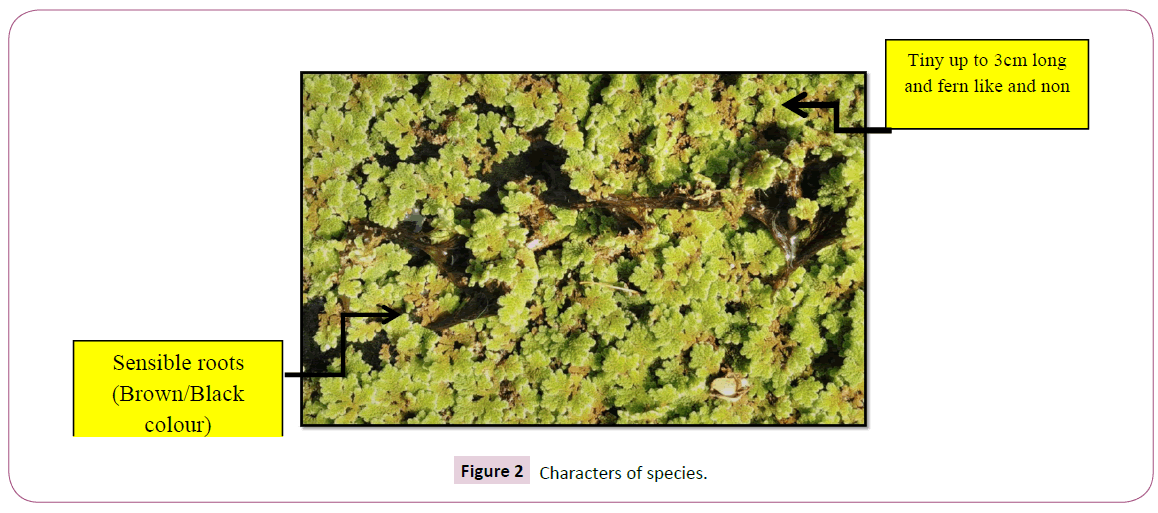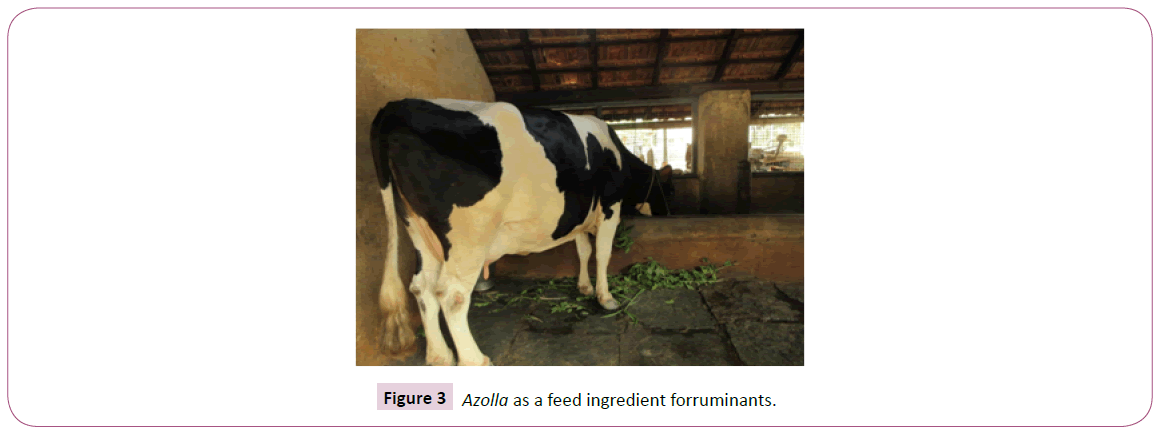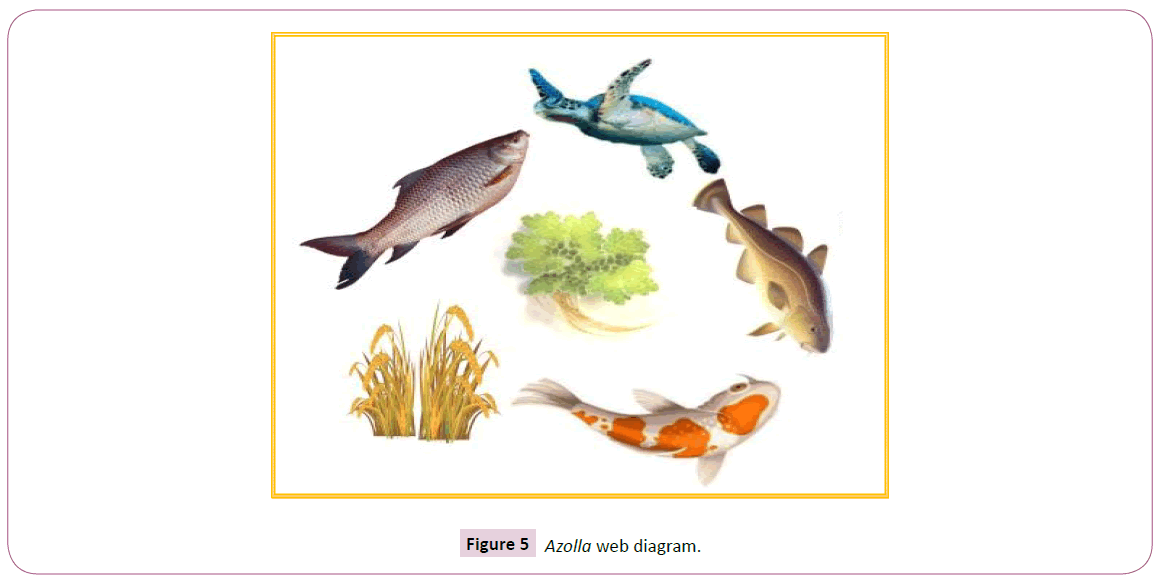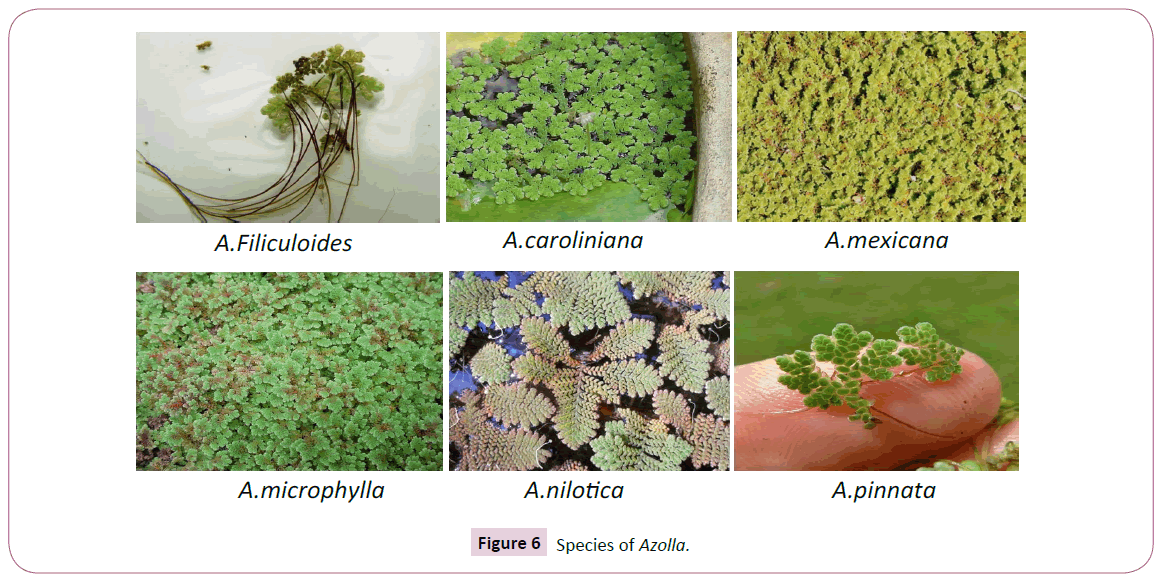Keywords
Azolla species; Food chain; Pollutants; Environment
Prologue
The aquatic free-floating fern, Azolla- universally called by names, ‘mosquito fern’, ‘fairy moss’, ‘aquatic fern’. Its diameter is about 1-3 cm (Figure 1). The genus belongs to the family Salvinacea which grows in association with the blue-green algae-a symbiotic partner i.e., Anabaena Azollae. Family Salviniales constitute of 2 genera: a. Salvinia (approx. 12 species) and b. Azolla(approx. 7 species) as shown in Table 1.
| Salvinia species (12 Nos.) |
Azolla species (6 Nos.) |
| Salvinia auriculata |
Azolla intertrappea |
| Salvinia biloba |
| Salvinia cucullata |
Azolla berryi |
| Salvinia hastata |
| Salvinia herzogii |
Azolla prisca |
| Salvinia minima |
| Salvinia molesta |
Azolla tertiaria |
| Salvinia natans |
| Salvinia nymphellula |
Azolla primaeva |
| Salvinia oblongifolia |
| Salvinia radula |
Azolla boliviensis |
| Salvinia sprucei |
Table 1. Various species of Azolla.
It is having a capability to double its biomass within 3-5 days.
Compared to other aquatic macrophytes, the protein content of Azolla is higher with all essential amino acids which are higher
to wheat bran, maize, offals, etc. One of the interesting facts is
that, Azolla plant contains probiotics and biopolymers and under
some unfavourable conditions, an anthocyanin pigment gives the
fern a reddish-brown colour (Figure 2).
Figure 2: Characters of species.
Azolla as a Fish Nourish
Azolla is very common in rice fields, natural ponds and marshy
ditches. It is considered as potential in fish culture, especially
in integrated culture of rice cum fish systems. Increased fish
production can be camouflaged in integrated rice with fish
cultivation. Increased production of fish faeces from Azolla fodder may be directly consumed by bottom dwellers in addition
to being used as an organic (nitrogenous) fertilizer to increase
overall pond productivity.
Conversely, it should be unspoken that the contribution of Azolla to aquaculture is interesting and alone could not ensure high productivity. It can be a useful supplement to natural feed in
low-input aquaculture. It has attracted attention as a nitrogenous
fertilizer and as a source of dietary nitrogen for herbivorous fish
and livestock. Therefore, it is an excellent inexpensive feed for
fishes. Dried and processed Azolla has been experimented as
feed ingredient to a number of fish species (e.g. tilapia, carps,
ornamental fishes, turtles etc.) for their effect on growth and
yield. In the similar manner, fresh Azolla as a complete diet
for high-density cage culture may not be economically viable.
However, Azolla may be useful in low density and low input cage
culture.
The high rates of decomposition of Azolla make it a suitable
substrate for enriching the detrital food chain or for microbial
processing such as composting, prior to application in ponds.
‘Rice-fish-Azolla’ integration increase the yield of both rice and
fish compared to rice-fish culture alone. The probable reasons
for the increase in rice yield are improved soil fertility resulting
from the augmented production of fish faeces from Azolla fodder reduce weed growth and adecreased incidence of insects
and pests. Fish yields can also be increased through the direct
consumption of Azolla (Figures 3 and 4).
Figure 3: Azolla as a feed ingredient forruminants.
Figure 4: Dense mats of Azolla.
World aquaculture production is likely to grow continuously, but
at slow rate. Azolla has gained its importance in aquaculture due
to higher crude protein content (13 to 30%) and Essential Amino
Acid (EAA) composition than most green forage crops and other
aquatic macrophytes and it contain several vitamins (Vit. A, B-12
and β-carotene) (Figures 5 and 6) (Table 2).
Figure 5: Azolla web diagram.
Figure 6: Species of Azolla.
| Sl. No. |
Constituents |
Dry matter (%) |
| 1 |
Ash |
10 |
| 2 |
Calcium |
0.4-1.0 |
| 3 |
Chlorophyll |
0.34-0.55 |
| 4 |
Crude fat |
3.3-3.6 |
| 5 |
Crude protein |
14.0-30.0 |
| 6 |
Iron |
0.06-0.26 |
| 7 |
Magnesium |
0.5-0.65 |
| 8 |
Nitrogen |
4.0-5.0 |
| 9 |
Phosphorus |
0.5-0.9 |
| 10 |
Potassium |
2.0-4.5 |
| 11 |
Soluble sugars |
3.4-3.5 |
| 12 |
Starch |
6.5 |
Table 2. Azolla composition.
Environmental Benefits
Limitation of nitrogen volatilization
When light intensity gets reduced in subsurface water, then Azolla will start the algae inhibition which leads to subsequent
increase in pH and NH3 volatilization. Because, up to 50% of
nitrogen fertilizer applied to paddy fields is lost in volatilization, Azolla could help to reduce the amount of nitrogen fertilizers in
rice crops.
Weed control and role in waste water treatment
Effluents from aquaculture ponds may add to receiving waters,
high levels of Biochemical Oxygen Demand (BOD), inorganic
particulate matter, living and dead particulate organic matter,
dissolved organic matter, ammonia, nitrite, nitrate, phosphate
and other potential contaminants. Therefore, regulatory agencies
have developed standards and criteria for the aquaculture
industry concerning effluents [1].
Azolla covering water surface reduce light penetration of soil
surface, resulting in the depreciation in the germination of weeds
(70% of the weed). Thus, growth of Azolla reduces aquatic weeds
in flooded rice fields. It has been empirically observed and well
appreciated by rice farmers that nutrients can be removed
completely with the help of tertiary treatment especially, nitrogen
(N) and phosphorus (P) which are discharged from wastewater
treatment plants that accelerated the eutrophication of lakes
and streams.
Owing to high increasing treatment costs, the use of various
aquatic plants can remove N and P, in view of the low energy
consumption to promote the preservation of the environmental
conditions. The plants such as Eichhornia, Lemna, Spirodella,
Ipomeaand various higher plants can be used but these plants
have disadvantages such as incomplete removal of Phosphorus
[2-6]. Eventually, due to the symbiotic N2 fixation, Azolla can grow
even after N2 is depleted in the effluents, resulting in adequate
removal of P [7].
Biogas production
Anaerobic fermentation of Azolla or a mixture of Azolla and rice
straw produces methane gas which can be utilized as fuel. The
remaining effluent can be used as a fertilizer as it contains all of
the nutrients originally incorporated in the plant tissues except
for a small amount of nitrogen lost as ammonia [8]. Nevertheless,
there has been little systematic research into Azolla potentiality
as a biogas source. Das et al. mixedcowdung and Azollapinnata residues and found that the best ratio was 1:0.4, which gave a gas production 1.4 times that of cow dung alone [9]. This indicates Azolla’s potential to produce biogas on an industrial scale.
Hydrogen source
There has been some research undertaken into Azolla to produce
hydrogen, a non-polluting, high-energy fuel. When Azolla- Anabaena are grown in a nitrogen-free atmosphere or a water
medium containing nitrate, the nitrogenase in the symbiont,
instead of fixing nitrogen that evolves hydrogen using water as
the source [10]. Newton recordedhydrogen production at rates
of 760 nmol (nanomole) of H2 per gram fresh weight of Azolla per h [11].
As per the demonstrations by Hall et al. the rate of hydrogen
production can be increased by [12]:
• Exposing Azolla to a micro-aerobic environment.
• Exposing Azolla to a partial vacuum.
• Exposing an argon-enriched or carbon dioxide-enriched
atmosphere.
• The immobilization of Anabaena cells isolated from the Azolla.
Cells may be immobilized by entrapment in transparent or
translucent gels or polymers in order to increase the functional
life time of the cells. Using a ‘trickling-medium’ column
bioreactor, Park et al.obtained a production rate of 83 ml H2 per
gram per day [13].
Removal of gold from wastewater
Gilding generates large volumes of wastewater with residual
gold, posing environmental and financial problems necessitating
metal recovery. Following earlier studieson Azolla by Khosravi et
al. and Umali et al. Found that Azolla filiculoides removed more
than 98% of gold from waste water in a gold plating factory and
developed a continuous flow column system that removed 100%
of the gold from waste water [14,15].
Green manure and N-fixation
In agriculture, Azolla has been traditionally used as a green
manure and an animal feed in Vietnam and China [16,17]. In rainy
season, Azolla can easily fix enough nitrogen for a 4 to 6 tonnes/
ha rice crop within 25 to 35 days whereas, during the summer
season, 5 to 8 tonnes/ha crop under irrigation. Soil fertility
contributed by the Azolla, providing nutrient-rich humus through
its decomposition. One of the main reasons for the popularity of Azolla among agriculturists is its ability to fix nitrogen, valuable
in paddy fields under waterlogged or flooded conditions where,
nitrogen fixating legumes cannot grow. It is also a source of green
manure for upland rice growing on the most fertile soils that
farmers are reluctant to use for legume crops.
Bioremediation
Bioremediation, an internal part of Environmental Biotechnology
Programs, explores the use of biological mechanisms to destroy,
transform or immobilize environmental contaminants to protect
potential sensitive receptors. The use of living organisms
(primarily microorganisms and plants) is emerging as one of the
most alternative technologies for removing contaminants from
the environment, restoring contaminants sites and preventing
further pollution. The natural biological processes explored to
remediate nutrient-rich water by converting nutrients into forms
that could be more easily removed. As the aquaculture industry
develops, efficient, cost-effective and environmentally friendly,
preventive and bioremediation methods of improving effluent water
quality prior to discharge into receiving waters of sensitive areas
becomes necessary [18]. Currently, aqua culturist has to follow the
discharge guidelines as stipulated by the Environmental Protection
Agencies where, Bioremediation or Bio-augmentation can be a great
aid. Azolla can accumulate excessive amounts of pollutants such as
heavy metals, radio-nuclides, dyes, pesticides, etc. Hence, it has
been extensively studied and tested since the 2000’s as a candidate
for the bioremediation of waste waters and effluents [19] (Table 3).
| Sl. No. |
Amino acids |
Percentage |
| 1. |
Alanine |
5.3-7.4 |
| 2. |
Arginine |
5.1-6.6 |
| 3. |
Aspartic acid |
8.2-10.3 |
| 4. |
Cystine |
0.7-2.3 |
| 5. |
Glutamic acid |
11.6-13.5 |
| 6. |
Glycine |
4.4-6.6 |
| 7. |
Histidine |
1.6-2.4 |
| 8. |
Isoleucine |
3.7-5.4 |
| 9. |
Leucine |
7-9.2 |
| 10. |
Lysine |
3.5-6.5 |
| 11. |
Methionine |
1.2-1.9 |
| 12. |
Phenylalanine |
5.2-5.6 |
| 13. |
Proline |
3.5-6.8 |
| 14. |
Serine |
3.9-5.6 |
| 15. |
Threonine |
4-5.3 |
| 16. |
Tryptophan |
1.5-2 |
| 17. |
Tyrosine |
3.2-4.1 |
| 18. |
Valine |
3.8-6.8 |
Table 3. Composition of amino acids.
Removal of heavy metal pollutants from water
Azollacanbeusedtopurifywaterpollutedbymetals.Jainetal.
foundthat Azollapinnata and Lemna minor (duckweed) removed
the heavy metals-iron and copper from polluted water when the
metals are present at low concentrations [20]. They concluded
that effluent containing metal pollutants in low concentrations
could be treated by passing it through ponds containing one or
both of these water plants. Saxenafound that a mixed culture
of Lemna and Azolla in the ratio of 2:1 was able to purify highly
polluted effluent from factories sufficiently for it to be used for
agricultural purposes [21].
Azolla’s potential to purify water has impending applications for
both industrial and mining operations as well as space exploration.
Fishes are the bio-indicator of metal pollution and are particularly
sensitive to wide variety of toxicants. As fish fauna serves as a
food source, it is essential to know the impact of water pollution
on these organisms. Reports available in the recent years suggest
the contamination of freshwater bodies by heavy metals coming
through industrial wastes leading to biological magnification
resulting into severe alteration in physiological and biochemical
parameters of fish.
Phytoremediation is considered one such remedy to solve the
problem of heavy metal pollution in water by using plants. The
ability of aquatic plants to accumulate toxic metals from water
can be removed by this process.
On phyto-accumulation potential of macrophytes with
emphasis on utilization of Azolla as a promising candidate for
phytoremediation has been dealt. The impact of uptake of
heavy metals on morphology and metabolic processes of Azolla has been argued for a better understanding and utilization of
symbiotic association in the field of phytoremediation [19].
Phytoremediation processes are having significant power to
remove Chemical Oxygen Demand (COD) increasing contaminants
from polluted water. In addition to this, it is also been proved
that water hyacinth and Ceratophyllum combinative treatment is
more convenient and useful to reduce COD level [22].
Contamination of fish in wastewater ponds
Aquaculture generates considerable amount of wastes, consisting
of metabolic byproducts, residual food, faecal matter, residues of
biocides and biostats, fertilizer derived wastes, wastes produced
during moulting and collapsing algal blooms and residual of
prophylactic and therapeutic inputs, leading to the deterioration
of water quality and disease out breaks. As a result, aquaculture
is now considered as a potential polluter of aquatic environment
and a cause of degradation of wetland areas (b).
No public health problems been reported so far, even though
the controversial hypothesis of influenza pandemics from pigduck-
fish-zoonosis in Chinese integrated farming, the possibility
of hazards continues to be raised, mainly because of successful
experimental infections [23]. Ponds fertilized with untreated
sewage or other wastes can contain human pathogenic
organisms. Laboratory experiments with tilapia, common carp
and silver carp have shown that when bacteria is present in high
concentrations in experimental ponds for long periods, could be recovered from all organs and muscles of fish, although normally
they are found in the digestive tract and not in muscle tissues.
Guidelines issued by the World Health Organization (WHO) for
the use of wastewater suggest that there is a little accumulation
of enteric organisms and pathogens on or penetrating into edible
fish tissue when faecal Coliform concentration in fish pond waters
is below 103 per 100ml [24]. Greater the concentrations to an
extent of 104 and 105 per 100ml, the potential for invasion of fish
muscle by bacteria increases with the duration of exposure of the
fish to the contaminated water.
Conclusion
Utilizing aquatic plants/microorganisms to detoxify effluents,
soils, etc., is getting such wide acceptance that ‘bioremediation’
and ‘phytoremediation’ has now become a common buzzword
in waste water management. When development and
intensification of aquaculture sector is inevitable for food
security and social well-being, it should be within the frame work
of sustainability and environmental friendly approach. It seems
likely that the use of bioremediations will gradually increase and
the success of aquaculture in future may be synonymous with
the success of bioremediation that, if validated through rigorous
scientific investigation and used wisely, may prove to be a boon
for the aquaculture industry.
References
- Yoo, Boyd CE (1994) Hydrology and water supply for pond aquaculture. Chapmanand Hall, New York.
- Cornwell DA, Zoltek JR, Patrinely TS, Furman, KIM JL (1977) Nutrient removal by water Hyacinths. J Water Pollut Contr Fed 70: 57-65.
- Harvey RM, FOX JL (1973) Nutrient Removal Using Lemna minor. J Water Pollut Control Fed 45:1928-1938.
- Matsumoto S (1981) Nutrient removal by Spirodela polyrhiza and its use (in Japanese). Chem Biol. Pp: 594-600.
- Hashimoto S (1983) Wastewater treatment by channel flow system and food production. Water Purif Liquid Wastes Treat24:17-24.
- Abe K, Ozaki Y, Kihou N (1993) Use of higher plants and bed filter materials for domestic waste water treatment in relation to resource recycling. Soil Sci Plant Nutr39:257-267.
- Shiomi N, Kitoh S (1987a) Use of Azollaas a decontaminant in sewage treatment. In: AzollaUtilization. Int Rice Res Institute. Pp: 169-176.
- Van Hove C (1989) Azollaand its multiple uses with emphasis on Africa. FAO, Rome, FAO. Pp: 53.
- Das, D, Sikdar K, Chetterjee AK (1994) Potential of Azolla pinnata as biogas generator and as a fish-feed. Indian J Environ Health36:186-191.
- Peters GA (1976) Studies on the Azolla-Anabaena Azollae symbiosis. In: Newton WE, Nyman CJ (eds.) Proc First International Symposium on Nitrogen Fixation. 2:592-610.
- Newton JW (1976) Photo-production of molecular hydrogen by a plant-algal symbiotic system. Science 191:559-561.
- Hall DO, Markov S, Watanabe AY, Rao KK (1995) The potential applications of Cyanobacterial photosynthesis for clean technologies. Photosyn Res46:159-167.
- Park IH, Rao KK, Hall DO (1991) Photo-production of hydrogen, hydrogen peroxide and ammonia using immobilized Cyanobacteria. Intl J Hydrogen Energy 16: 313-318.
- Khosravi M, Rakhshaee R, Ganji MT (2005) Pretreatment processes of Azolla filiculoides to remove Pb(II), Cd(II), Ni(II) and Zn(II) from aqueous solution in the batch and fixed-bed reactors. J Hazard Mater 127: 228-237.
- Umali LJ, Duncan JR, Burgess JE (2006) Performance of dead Azolla filiculoides biomass in biosorption of Au from wastewater. Biotechnol Letters 28: 45-50.
- Dao TT, Tran QT (1979) The use of Azollain rice production in Vietnam. In: Nitrogen and Rice. Int Rice Res Institute395-405.
- Lumpkin TA, Plucknett A (1980) Azolla: Botany, physiology and use as a green manure. Econ Bot 34:111-153.
- Jones AB, Dennison WC, Preston NP (2001) Integrated treatment of shrimp effluent by sedimentation, oyster filtration and macro algal absorption: A laboratory scale study. Aquaculture 193:155-178.
- Sood A, Uniyal PL, Prasanna R, Ahluwalia AS (2012) Phyto-remediation potential of aquatic macrophyte, Azolla. J Hum Environ41:122-137.
- Jain SK, Vasudevan P, Jha NK (1989) Removal of some heavy metals from polluted water by aquatic plants: Studies on duckweed and water velvet. Biol Wastes28: 115-126.
- Saxena DK (1995) Purification efficiency of Lemna and Azollafor WIMCO effluent. Prec Natl Acad Sci 65:61-65.
- Sudani RB, Thumma DM, Sojitra KM, Gajera AD, Bbavriya SS (2014b) Lab scale study of water hyacinth for bioremediation of waste water, Valsad, India. Int J Res Adv Technol 2: 2321-9637.
- Schotissek C, Naylor ER (1988) Fish farming and influenza pandemics. Nature 331:215.
- WHO (1989) Health guidelines for the use of waste water in agriculture and aquaculture. WHO Technical Report Serious 778:43.







